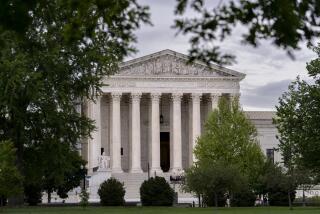Students Put Heads Together, Rally at the Drop of Their Hats
- Share via
Chanting “Hats, hats, hats,” a group of about 75 University High School students gathered outside the school Thursday to protest a new edict banning headgear from the campus as distracting and gang symbolism.
“I feel it’s kind of bogus to take away our rights to wear what we want to wear,” student M. Zachary Sherman said.
The hat ban was the first controversial decision of the school’s newly formed “Shared Decision-Making Council” made up of the principal, teachers, parents and community members, a power-sharing arrangement that was a key part of the teachers’ strike settlement last year.
The edict went into effect Thursday when students getting off the buses were asked to take off their hats or have them confiscated.
Though they were warned and granted one last “hat day” on Wednesday, many students contended that the rule violated their freedom of expression.
An unsuspecting military recruiter in full uniform who walked into the school during the protest was grist for their mill. “Take your hat off. It’s gang-related,” the students yelled.
Junior Patrick Stehy, 16, usually not a hat wearer, donned a tan plaid hat that belonged to his grandfather for the protest. “You can’t solve the gang problem at the drop of the hat,” Stehy said.
Although the council’s vote to ban headgear was unanimous, school officials acknowledged that the West Los Angeles school does not have a significant gang problem. University High Principal Jack S. Moscowitz and campus police Officer Walter Martin said that the number of identified gang members at the 2,200-student school was minimal and that no specific incident had spawned the ban.
Noting that attempting to keep current with the ever-changing symbolism of gangs was extremely difficult, Martin said: “Rather than going crazy, it’s no hats, period. There’s no place for a hat at school.”
School districts and individual schools in and around Los Angeles have adopted bans of gang-related clothing in recent years in an effort to curb gang activity. A few have invoked specific hat bans similar to University High’s; more common are broad dress codes designed to restrict all kinds of clothing and accessories that might be construed as gang-related.
On Thursday, University students protested the new rule during the noon hour--and in some cases all day--by refusing to remove their hats when asked by a teacher.
When the lunch bell rang, student protesters spilled out of the school wearing all manner of headgear--paper hats, a marching band hat, baseball caps of every hue and team affiliation. One hat said, “I hate sea gulls,” while another sported a hand-lettered “Hell no! Hats won’t go” sign.
Some students had made unofficial University High spirit hats, the only head covering allowed. Ironically, the students noted, the school hats are blue, a color associated with the Crips gangs.
Protesters contended that outlawing hats violated their freedom of expression and was potentially the first step toward a dress code. “It’s bull,”’ said Jay Boone, 17. “Maybe next they’ll want us to come to school in uniform like little soldiers.”
Many of the teen-agers scoffed at the idea that banning hats would curb the few gang members on campus.
Outlawing hats to combat gangs “is like using a Band-Aid for a bullet wound,” said Michael Goldstein, 17. “It’s ridiculous. It’s not going to solve the problem.”
Tracy Johnson, 17, said the administration should concentrate on the isolated gang members, rather than going after everyone.
Administrators kept down the crowd by policing the front door and checking lunch passes. Only seniors are allowed outside at lunch, although some others hopped over the fence to join the crowd.
Moscowitz played down the extent of the dissatisfaction, portraying the protesters as a small “nucleus of students agitating to change the rule” joined by a group of “opportunistic students on a lark.” He said he was taking a low-key approach to enforcement. “We’re trying to play it without being confrontational,” Moscowitz said.
The names of students who refused to relinquish their hats were taken and each of them is being individually counseled about the new rule. “We don’t arrest students for wearing hats,” he said.
However, Daniel Douglas, 17, said he was placed in handcuffs and had the red marks on his wrists to show for it. Douglas said he was handcuffed when he refused to surrender his Chicago Bulls cap to security officers.
Moscowitz confirmed that a student was handcuffed for being out of control and for trying to incite a class to walk out over the ban.
When the lunch bell rang again, students crowded back into school.
Assistant Principal Keiko Hentell stood at the door examining passes before allowing students to enter and taking names of those without permission to be out in front of the school.
“We’re protesters,” protester Sherman said. “We don’t have lunch passes.”
Hentell, meanwhile, got so wrapped in what she was doing that she appeared to forget the day’s mission.
“Did I forget to take their hats?” she asked.
More to Read
Sign up for Essential California
The most important California stories and recommendations in your inbox every morning.
You may occasionally receive promotional content from the Los Angeles Times.













